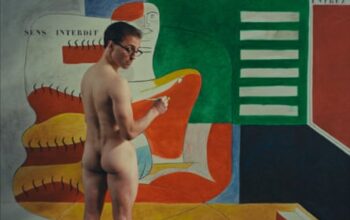Have you ever wondered whether the interview you’re about to read is actually real? Are you reading it thanks to your own free will, or are you merely set on a preprogrammed course that’s entirely out of your control? Is everything just code? Are we a simulation?
These are the questions that arise when you spend an hour with director and artist Harmony Korine, who is the first interviewee I’ve ever had respond to one of my questions by wondering whether or not I actually exist.
“I can’t change it, you know,” he shrugs, when I ask if he’s worried about the perilous state of the world. “And then you think, ‘Is any of this even real? Like, are you really sitting there? Do you know what I’m saying?’”
Korine often ends his more outre musings with this question (“We’ve all become transhuman, but now glitches are starting to appear, do you know what I mean?”). To which the answer is usually, well, no, not entirely, Harmony. But I nod along anyway because talking to him is a lot of fun: in parts intense, illuminating, bizarre – oh look, he’s jumped up to start tap dancing! – confusing and funny.
It’s 10 o’clock in the morning when we meet at a London art gallery and Korine has already started the day in his favourite way – by smoking two fat cigars.
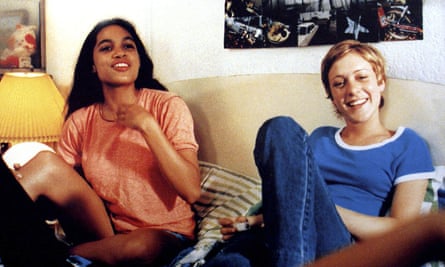
“I can’t really think unless I have a cigar,” he says, reaching into his jacket to show me a pristine Padrón he’s saving for later. I tell him that I can’t think of anything I’d want less first thing in the morning.
“Yeah, that’s why I do it,” he says. “The last thing people want is the thing I want the most.”
Korine didn’t make his name by obeying convention. Still lauded for writing the 1995 Larry Clark film Kids at the age of 19, his career ever since has been a masterclass in following his own vision, without ever courting mainstream approval. His 1997 directorial debut Gummo remains an astonishing collage of cat murder, death metal and men fighting with chairs that exposed the weirdo fringes of American society previously hidden from cinema screens.
Since then he has made a film about schizophrenia (1999’s Julien Donkey-Boy), abandoned a project in which he tried to get himself repeatedly beaten senseless by strangers (Fight Harm) and spent the best part of a decade in the wilderness after two house fires and some serious drug problems. He returned in the mid-00s with various art shows and movies, including one in which older people are filmed on VHS home video recorders having sex with bags of garbage (2009’s Trash Humpers).
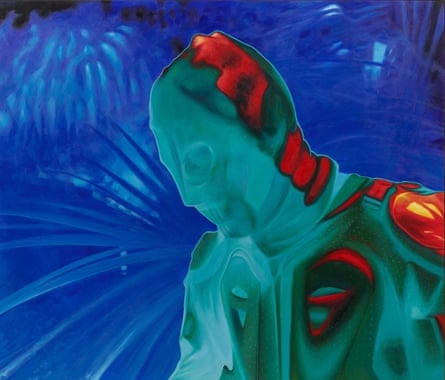
Last year, Korine released Aggro Dr1ft, a largely plot-free extravaganza revolving around an assassin. Filmed using infrared cameras and featuring deliberately contrived and repetitive dialogue, it didn’t exactly threaten to topple Barbenheimer at the box office. But it did have critics arguing about whether it was a) incredibly boring, b) the future of film-making or, in some cases, c) both at the same time.
It’s that film which has brought us here today, for a new exhibition of retina-burning oil paintings Korine has created from the movie’s stills. In these images, depictions of the film’s characters come second to the colours: squint-inducing reds, yellows, blues and oranges that scorch the canvas. “We used a lot of chemicals to push the colours as far as we could, until they basically corroded,” he says proudly.
There’s not much point trying to pin Korine down on the meaning of his work. “I have no interest in doing a deep introspection,” he says. “I’m just trying to show you things in a way that I haven’t seen before.” His movies largely eschew plot in favour of “vibe”, and these paintings are no different. Does he never get the urge to deliver a message?
“A message?” he says, scrunching his nose. “No. That’s disgusting!”
Disgusting? I laugh.
“I wouldn’t even know how to approach a message. The older I’ve gotten, the less I know.”
So the dystopian imagery in this exhibition does not in any way reflect his worries about climate breakdown (“I don’t know anything about that”), and he shrugs off the idea that the focus on solitary male rebels is an unusual choice in an art world drifting away from traditional masculinity to explore more marginalised identities. Rather, he says, the whole thing was inspired by video game aesthetics and their ability to create new visual worlds.
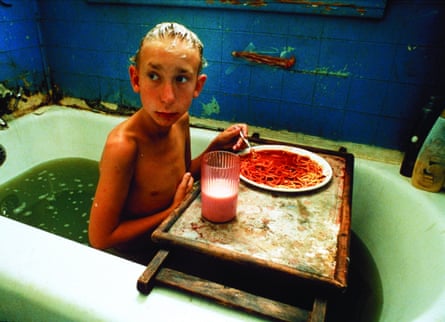
Korine often watches streams of gamers playing. “Sometimes they go on for five days. You watch it at breakfast, go to work, and when you come back it’s still going. It feels like it never ends. Then you start to ask yourself, ‘Is there even any meaning to it?’ And then you’re like, is there any meaning to anything? Some people would say that’s demoralising and horrible. But there is another side that says, well, actually now we’re really free. Because once you’re free of meaning and old-school narrative logic, then all you’re left with is the vapours and the vibrations … do you know what I’m saying?”
Although Korine’s younger years are often depicted as a period of unruly delinquency – fights, drugs, skateboarding – for as long as he can remember he was also painting, making collages, writing things. “It wasn’t, like, art,” he says. “I wasn’t trying to be a painter or whatever, I was just fucking around. When I was a kid, I could pick up a ukulele and just hit a string for hours and hours and hours. In my mind, it was like the greatest thing. In reality, it was probably the worst, but I was entertained.”
Korine was also a dedicated tap fan – his father danced and they would watch the greats such as the Nicholas Brothers. A group of his friends would even tap dance together on the pavement. “We called it kerb dancing. It was almost like doing skateboard tricks but on tap shoes. A lot like gangster walking, you know, Crip walking.”
There was no roadmap for becoming a director in Nashville where he grew up, but when Larry Clark spotted him skateboarding in New York and asked him to write a script for Kids he threw himself into the task. “I was obsessed,” Korine says. Soon he was being lauded as cinema’s next auteur, but the attention that came with Kids and Gummo became too much.
“I just burned out. I couldn’t handle it and I didn’t even know if that’s what I wanted to do,” he says, although his description of his wilderness years is rather different from the crack cocaine stories of lore. “I just started, like, mowing lawns,” he says. “Delivering flowers.”
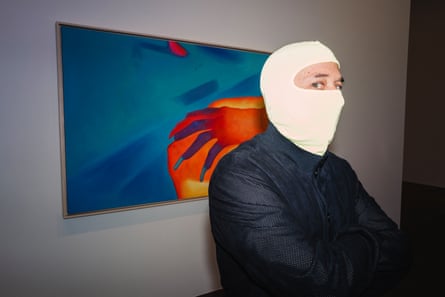
Delivering flowers?
“Yeah. I even did that recently, for a couple of weeks. I thought, well, the people that deliver flowers get to go to all these houses and condos that I’ve never seen before in Miami, which is where I live now. So I thought it would be fun.”
Budding tap dancers with a penchant for flower delivery don’t usually pick up the tag of enfant terrible, but it was obvious from the start that Korine was out to upend things. Even at the age of 51, and now the father of three kids with his wife, Rachel, he says it’s still fair to call him one. But he believes the real disruptors these days are no longer making films: instead he heads to TikTok where “kids from India, Bangladesh and the Middle East are making horror movies and things that are just beyond anything I’ve ever done”.
Korine has always seen the world in a visual way. “It’s an affliction,” he says. “I can’t even read books or scripts because I spend the entire time imagining the room or the streets. It’s exhausting.”
Maybe so, but from the moment I first watched Gummo, I’ve been intrigued as to what it’s like living inside his head.
“I wouldn’t wish that on anybody, it’s trippy,” he says with a smile.
Is that why he finds it so hard explaining his motives? Perhaps, but towards the end of our conversation he breaks off from one of his more impenetrable passages and takes a different approach: “The most beautiful thing in the world to me is an empty parking lot at night,” he says. “You know, with the street lamps and an overturned milk crate. It’s mostly me trying to show you that. Do you know what I’m saying?”
And actually, this time, I think I sort of do.
Our time up, Korine heads off to meet the photographer inside the gallery. When I pop over to say goodbye I find him pulling on – what else? – a fluorescent green balaclava for the photoshoot. He is adamant that he shouldn’t be pictured without it. Our photographer is not so sure: “We want people to know that it’s you,” she reasons.
“This is me,” says Korine. And he’s probably right. If, that is, he even exists.
Source: theguardian.com
